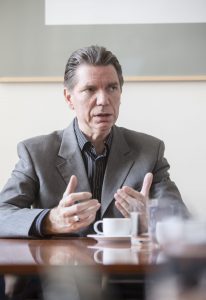Mr Hegner, why is the Humboldt Forum also a venue for contemporary art?
Hans-Dieter Hegner: The Humboldt Forum will be a modern cultural venue with museums, exhibitions and events. We won’t be restricted to any particular genre or era. And precisely because we’re going to be an international institution as well, contemporary artists from all around the world will be shown here.
Lars-Christian Koch: Of course, the ethnological collections are particularly notable for their historical depth. Nonetheless, it is our job to make the Humboldt Forum a forum for now, for the present day. One aspect of this is naturally international contemporary art. That doesn’t mean the ethnological collections of the Staatliche Museen zu Berlin are going to switch completely over to contemporary art. But modern art will play a major role in our exhibitions. We want to present other aspects of non-European collections. Works of contemporary art have been part of the ethnological collections for a considerable time now. But this kind of art doesn’t come about just because I label it art; it’s created by exhibitions and educational activities.
We won’t be restricted to any particular genre or era.
In addition to the contemporary works from the ethnological collections of the Staatliche Museen there will also be a number of Kunst am Bau or “percent for art” projects on show at the Humboldt Forum. To what extent will these interact with the collections?
Hans-Dieter Hegner: I just mentioned that we want to be a modern cultural institution. In this respect we won’t just be looking at the individual museums situated within. In addition to its function we’re interested in the site itself. The background is that whenever central government takes on the role of construction client, between 0.5 and 1.5 per cent of the construction costs have to be spent on art for the building. That is a voluntary commitment by central government. We have selected four locations in the building for these art projects: the two staircases above Gates I and IV, the large staircase and the small foyer which will lead to the event rooms and the vestibule of the Berlin Exhibition and the Humboldt Forum Academy. The winning designs for the staircases include one by the artists An Seebach and Christiane Stegat which consciously explores the Humboldt Forum collections, graphically reworking objects from the collections into a Baroque context. I think it’s a highly successful piece. The Berlin collections can trace their roots back to the chamber of art and curiosities in the Baroque palace. Now, with the Humboldt Forum the collections are returning to the place they were first housed.
Was it a precondition for participating in the competition that artists should deal with the building’s history?
Hans-Dieter Hegner: It was an open competition. But we made it clear that we were looking for works that explored the ideas of the Humboldt brothers, or internationality or the site itself. In the first competition we received over two hundred entries. And the list of competitors was extremely international.
We will, however, indeed be showing a piece by Ai Weiwei.
The second competition produced a winning entry by Sunkoo Kang, a student of Ai Weiwei. Would Ai Weiwei himself be an artist you’d show in the ethnological exhibitions? Or do his works really belong in the Hamburger Bahnhof collection?
Lars-Chrisian Koch: We have to deal with this kind of cataloguing every single day. We will, however, indeed be showing a piece by Ai Weiwei. Moreover, we have a large exhibition hall which has been designed by a Chinese artist and architect. In the Schweizersaal, by contrast, we have an entire wall designed by Mariana Deball. And then there will be a work of art from Cameroon on show which explores the problems in that country today. So we don’t just want to present art. We want to show works that really investigate our collections.
Hans-Dieter Hegner: The construction team and the museums are cooperating well in this area. Right now we’re sourcing a new Japanese teahouse. There’s always been a teahouse in the Asiatisches Museum in Dahlem, but we couldn’t just tear it out of the museum. So we put out an open-call to Japanese artists and architects, and right now we’re commissioning the winner to build a new teahouse.
Lars-Chrisian Koch: That’s certainly a good example of how contemporary art helps improve people’s understanding of a country’s culture.
